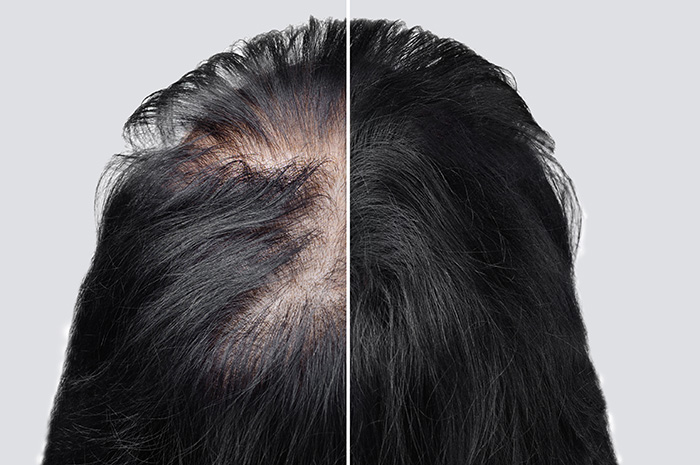You probably haven’t given your physical appearance much attention over the previous several years regarding COVID-related symptoms. Most COVID consequences, whether respiratory discomfort or inflammation that might cause a loss of smell, are invisible to other people.
Patients have been astonished to discover clumps of hair falling from their scalps months after contracting COVID. The coronavirus has continued to infect people worldwide. Many individuals have begun to worry that COVID might cause hair loss due to this development. Yes, but the more urgent question is whether individuals need to be concerned about the long-term effects of these hair changes.
Hair loss after COVID
About 5 million hair follicles in the human body go through a three-step process daily. In the anagen stage, hair first develops and bursts through the skin. After that, during the catagen stage, hair dies. Finally, during the telogen stage, hair sheds and grows back. You lose between 50 and 100 hairs daily.
85 to 90% of the time, or between two and four years, the hair follicles are still in the anagen (growth) stage. In contrast, the telogen (rest) stage may only last two to four months.

The physical and mental strain brought on by COVID may occasionally cause what seems to be hair loss. Instead of losing hair, COVID makes hair shed more often than usual.
COVID and telogen effluvium
Acute telogen effluvium is the medical name for transient hair loss. Your body is shocked by the stimuli brought on by COVID, which throws off the growth-rest cycle. Several months after contracting COVID, the outcome is significant hair loss; up to 30 to 50 percent of hair follicles are in the telogen stage, as opposed to 5 to 10%.
It’s not simply COVID that causes telogen effluvium. Numerous factors, including viral infections, surgery recovery, hospitalization, hormonal changes, and stress, can cause it. Hair loss may occur in certain persons due to COVID, a viral illness that can cause stress and hospitalization.
Physical stresses can be as minor for COVID patients as having a high temperature or needing to be put on a ventilator because of mild to severe respiratory difficulties.
When it comes to mental pressures, living with COVID has a toll that might affect how you feel and think. Hair follicle stem cells may enter a longer resting phase due to stress hormones produced by these alterations. More precisely, stress can affect dermal papilla cells, which are found at the base of hair follicles, and can prevent chemicals required for hair development.

Some people with mild COVID symptoms may have severe hair loss. In contrast, others with severe COVID symptoms may exhibit modest hair loss. The severity of hair loss isn’t always directly related to the severity of the condition.
How soon does hair loss start?
You’ll often observe hair loss two to three months after infection, unlike most COVID symptoms, which show up days or weeks after infection. In most non-COVID instances of telogen effluvium, hair loss starts in three months or less.
However, studies conducted over the past few years have indicated that COVID has accelerated the timetable. The median average onset of telogen effluvium was 45 days in little research, including 30 COVID patients. What most individuals find confusing about these symptoms is their delayed nature.
People frequently notice changes to their hair if irritating the scalp because more hair follicles than usual are in the latent state and have started to shed. Initially, hair clumps will appear after a shower or when combing your hair. After you see hair clumps, your hair will soon begin to thin.
It’s crucial to remember that hair loss results from a disturbance in the growth-regeneration process rather than actual hair damage. Because the follicles are still there, hair will come back over time.
What is the duration of COVID hair loss?
The good news is that COVID-related hair loss is often a serious problem and will ultimately regrow. But patience is required because regrowth can take up to 18 months to fully recover, ranging from six to nine months.
If your hair stays thin for a while, don’t be worried. A centimeter of hair grows on average per month. You’ll initially observe short, baby hairs that gradually become thicker and fuller on your scalp. For ladies with longer hair, it may take two years or longer to grow back long enough to feel “full” in a ponytail.
As for medicine, it is not advised to use it to cure severe hair loss. Other than patience, the most excellent strategy to stop additional hair loss is treating your hair gently. When combing your hair, try not to pull on it, and apply conditioner after a shower to get rid of tangles. Curling irons, hair straighteners, and other heated styling tools can weaken or harm your hair follicles.
Wearing a hat in the summer helps lessen damage from intense UV radiation. Although wearing hair in a tight ponytail or headband may be relaxing, the tension on the hair might cause it to weaken and make it more prone to falling out. Any hairstyles that put a strain on your hair should be avoided.

Engaging in stress-relieving activities like yoga, meditation, or physical activity is also advantageous. There is a cyclical association between acute hair loss and stress in many instances. Unwanted stress can be caused by hair loss, and stress can exacerbate hair loss.
While most occurrences of COVID are transient, it can sometimes result in chronic telogen effluvium that lasts for years. Regular hair shedding is most likely to impact those who have long-lasting COVID symptoms.
